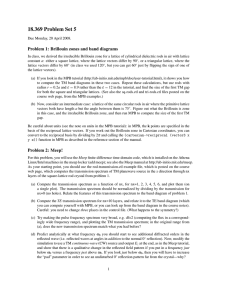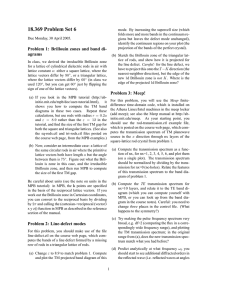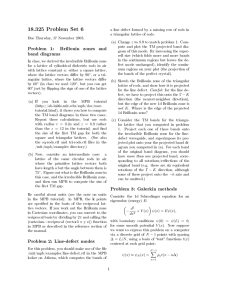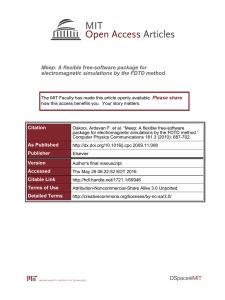18.369 Problem Set 5 Problem 1: Dispersion
advertisement
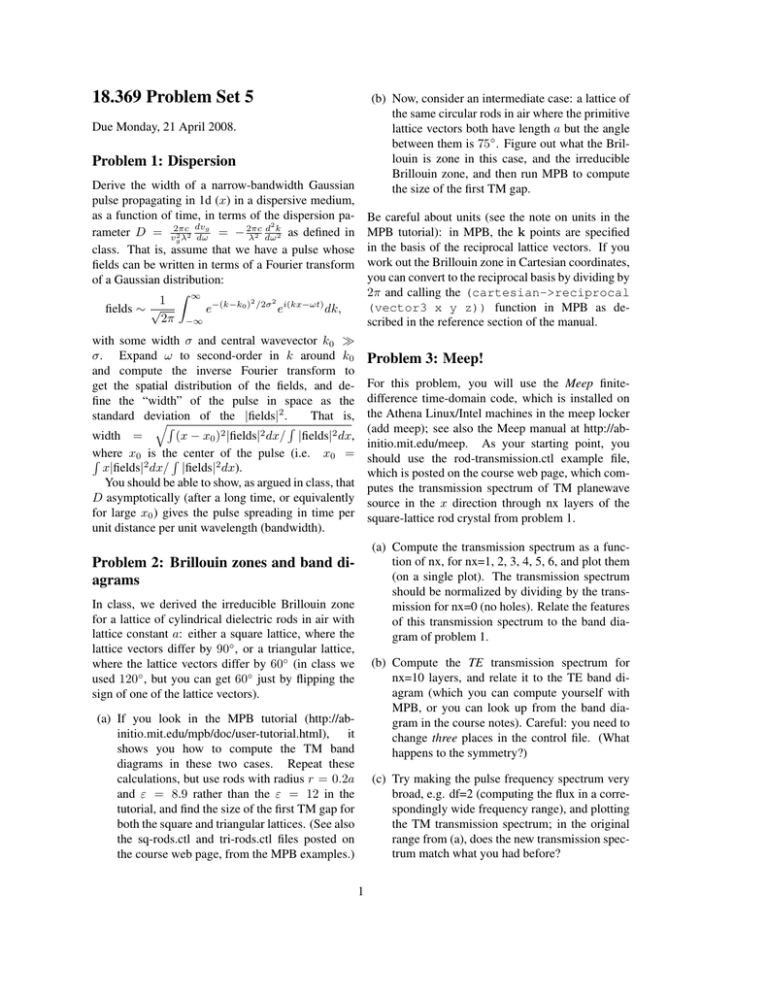
18.369 Problem Set 5 (b) Now, consider an intermediate case: a lattice of the same circular rods in air where the primitive lattice vectors both have length a but the angle between them is 75◦ . Figure out what the Brillouin is zone in this case, and the irreducible Brillouin zone, and then run MPB to compute the size of the first TM gap. Due Monday, 21 April 2008. Problem 1: Dispersion Derive the width of a narrow-bandwidth Gaussian pulse propagating in 1d (x) in a dispersive medium, as a function of time, in terms of the dispersion padvg d2 k rameter D = v2πc = − 2πc 2 2 dω λ2 dω 2 as defined in gλ class. That is, assume that we have a pulse whose fields can be written in terms of a Fourier transform of a Gaussian distribution: Z ∞ 2 2 1 e−(k−k0 ) /2σ ei(kx−ωt) dk, fields ∼ √ 2π −∞ Be careful about units (see the note on units in the MPB tutorial): in MPB, the k points are specified in the basis of the reciprocal lattice vectors. If you work out the Brillouin zone in Cartesian coordinates, you can convert to the reciprocal basis by dividing by 2π and calling the (cartesian->reciprocal (vector3 x y z)) function in MPB as described in the reference section of the manual. with some width σ and central wavevector k0 σ. Expand ω to second-order in k around k0 and compute the inverse Fourier transform to get the spatial distribution of the fields, and define the “width” of the pulse in space as the standard deviation of the |fields|2 . That is, qR R 2 2 width = (x − x0 ) |fields| dx/ |fields|2 dx, Rwhere x0 2is theR center 2of the pulse (i.e. x0 = x|fields| dx/ |fields| dx). You should be able to show, as argued in class, that D asymptotically (after a long time, or equivalently for large x0 ) gives the pulse spreading in time per unit distance per unit wavelength (bandwidth). Problem 3: Meep! For this problem, you will use the Meep finitedifference time-domain code, which is installed on the Athena Linux/Intel machines in the meep locker (add meep); see also the Meep manual at http://abinitio.mit.edu/meep. As your starting point, you should use the rod-transmission.ctl example file, which is posted on the course web page, which computes the transmission spectrum of TM planewave source in the x direction through nx layers of the square-lattice rod crystal from problem 1. (a) Compute the transmission spectrum as a function of nx, for nx=1, 2, 3, 4, 5, 6, and plot them (on a single plot). The transmission spectrum should be normalized by dividing by the transmission for nx=0 (no holes). Relate the features of this transmission spectrum to the band diagram of problem 1. Problem 2: Brillouin zones and band diagrams In class, we derived the irreducible Brillouin zone for a lattice of cylindrical dielectric rods in air with lattice constant a: either a square lattice, where the lattice vectors differ by 90◦ , or a triangular lattice, where the lattice vectors differ by 60◦ (in class we used 120◦ , but you can get 60◦ just by flipping the sign of one of the lattice vectors). (b) Compute the TE transmission spectrum for nx=10 layers, and relate it to the TE band diagram (which you can compute yourself with MPB, or you can look up from the band diagram in the course notes). Careful: you need to change three places in the control file. (What happens to the symmetry?) (a) If you look in the MPB tutorial (http://abinitio.mit.edu/mpb/doc/user-tutorial.html), it shows you how to compute the TM band diagrams in these two cases. Repeat these calculations, but use rods with radius r = 0.2a and ε = 8.9 rather than the ε = 12 in the tutorial, and find the size of the first TM gap for both the square and triangular lattices. (See also the sq-rods.ctl and tri-rods.ctl files posted on the course web page, from the MPB examples.) (c) Try making the pulse frequency spectrum very broad, e.g. df=2 (computing the flux in a correspondingly wide frequency range), and plotting the TM transmission spectrum; in the original range from (a), does the new transmission spectrum match what you had before? 1 (d) Predict analytically at what frequency ω0 you should start to see additional diffracted orders in the reflected wave (i.e. reflected waves at angles in addition to the normal 0◦ reflection). Now, modify the simulation to use a TM continuouswave (CW) source and output Ez at the end, as in the Meep tutorial, and show that there is a qualitative change in the reflected field pattern if you put in a frequency just below ω0 versus a frequency just above ω0 . If you look just below ω0 , then you will have to increase the “pad” parameter in order to see an undisturbed 0◦ reflection pattern far from the crystal—why? 2
